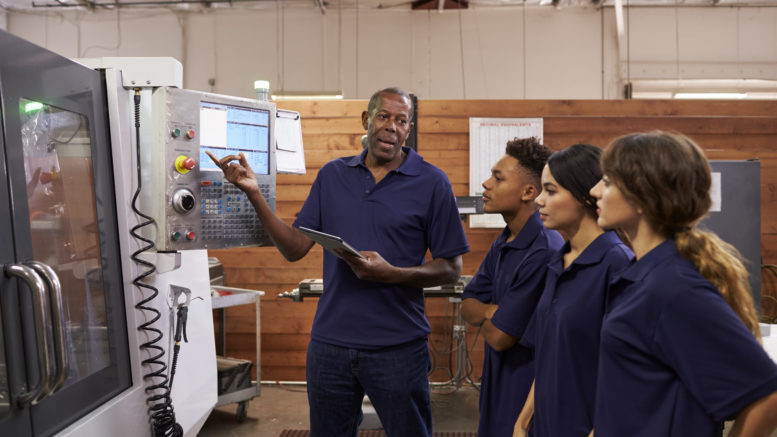Employers participating in the virtual High Impact Technology Exchange Conference (HI-TEC) agreed that COVID-19 has sharpened their need for technicians — whether they are among the small group of employees working on-site during the pandemic or among the masses working from home — with multiple high-tech skills and strong communication capabilities.
“We’re really looking for those high-functioning technicians that have the ability to communicate,” said Matthew Carter, vice president of COOK Medical in Winston-Salem, North Carolina.
Carter emphasized that technicians must often explain technical information to co-workers in cross-discipline teams.
“Anything you can do to allow students to have the opportunity to present information, to look at something and give an actual presentation, that’s a benefit,” Carter said during a panel discussion on Thursday.
The principal investigators of Advanced Technological Education (ATE) initiatives, funded with grants from the National Science Foundation, convene HI-TEC annually to showcase their model programs and share innovative programs with other educators and employers. This year’s meeting was held remotely. All the sessions may be viewed online.
Using the time to upgrade
Despite COVID’s many challenges, several panelists pointed out that some companies are taking advantage of COVID-induced slowdowns to install more equipment that “talks” to other equipment, which is further escalating the need for technicians who have fluency in the Internet of Things (IoT).
“Digitalization of factories to become more effective at producing equipment requires this higher technology and requires technicians to be proficient in technology, programming and network systems. In addition, other competencies include communication, troubleshooting, good analytical skills, initiative and teamwork,” said Scot McLemore, manager of talent acquisition and mobility at Honda North America, Inc., in Marysville, Ohio.
McLemore recommended that community college faculty include computer technology, programming and robotics in their technician education curricula. He also encouraged them to offer collaborative work-based learning opportunities for students like those that Columbus State Community College (Ohio) and Honda have developed with ATE funding.
Aaron Burciaga, global operations director of analytics and artificial intelligence for HCL Technologies in Leesburg, Virginia, added data analytics to this list.
The voluminous data generated by modern equipment requires people who can automate systems and write computer code, he said, noting that the National Convergence Technology Center at Collin College (Texas) is working with 500 employers to update information technology (IT) skill standards for application across industry sectors.
James Auld, director of external training for NextEra/Florida Power and Light Education Initiatives in Juno Beach, Florida, said he is excited about two ATE centers’ collaboration to use energy consumption data from multiple college campuses to replicate the type of information that energy technicians must analyze and respond to in their jobs. Auld is one of the industry advisors for the project led by the Regional Center for Nuclear Education and Training (RCNET) at Indian River State College (Florida) and the Center for Renewable Energy Advanced Technological Education (CREATE) at Madison Area Technical College (Wisconsin) that is creating an open-source system for using real data from supervisory controls and data acquisition (SCADA) systems in classroom projects.
“Training engineers and technicians in SCADA is paramount for career readiness,” Auld said.
Weaving in new concepts
The panelists, who serve as advisors to ATE centers, said they were aware of the difficulties community college educators face in adding more courses to already-packed associate degree programs.
Rather than create new courses, Mike Russo, vice president of industry advancement and government programs for SEMI in Washington, D.C., suggested that technician educators “weave” emerging technical concepts, such as predictive analytics, and basic business management into existing courses. This approach would give students competencies that they could apply in various fields.
“Students should search out, find and explore opportunities that align them — take their investments of time and money — and align them with multiple careers and educational pathways. Experience as much as you can and set yourself up with those core foundational skills,” Russo said.
Matt Glover, chief technical officer of Le-Vel Brands, put it in starker terms: “If you really want to develop students that are really transforming the industry, people who get and keep jobs … [they must] see across the horizon of the business needs and understand the business process — what they are specifically doing and how they can apply and overlay technology on to that. That is the quintessential game-changer in the world that I’m seeing of online workers and IT professionals today.”
V. Celeste Carter, lead program director of ATE, was so impressed by the panel discussion that she joined it to say she liked the idea of helping students understand industries and how skilled technician workers add value to companies’ products.
“Don’t try to make it all these separate things that you stick on to a program. Interweave it so that students come out with that understanding,” Carter said.

